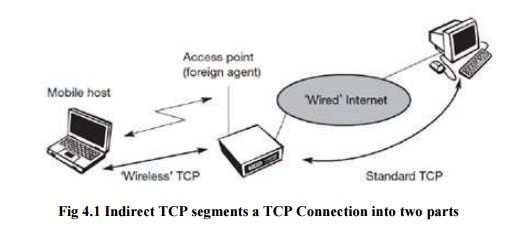Chapter: Mobile Networks : Transport and Application Layers
Mobile TCP and its Advantages
MOBILE TCP
The M-TCP (mobile TCP)1 approach has the
same goals as I-TCP and snooping TCP: to prevent the sender window from
shrinking if bit errors or disconnection but not congestion cause current
problems. M-TCP wants to improve overall throughput, to lower the delay, to
maintain end-to-end semantics of TCP, and to provide a more efficient handover.
Additionally, M-TCP is especially adapted to the problems arising from lengthy
or frequent disconnections (Brown, 1997). M-TCP splits the TCP connection into
two parts as I-TCP does. An unmodified TCP is used on the standard host-supervisory host (SH) connection, while
an optimized TCP is used on the SH-MH connection. The supervisory host is
responsible for exchanging data between both parts similar to the proxy in ITCP
(see Figure 9.1).

The M-TCP
approach assumes a relatively low bit error rate on the wireless link.
Therefore, it does not perform caching/retransmission of data via the SH. If a
packet is lost on the wireless link, it has to be retransmitted by the original
sender. This maintains the TCP end-to-end semantics. The SH monitors all
packets sent to the MH and ACKs returned from the MH. If the SH does not
receive an ACK for some time, it assumes that the MH is disconnected. It then
chokes the sender by setting the sender‟s window size to 0. Setting the window
size to 0 forces the sender to go into persistent
mode, i.e., the state of the sender will not change no matter how long the
receiver is disconnected. This means that the sender will not try to retransmit
data. As soon as the SH (either the old SH or a new SH) detects connectivity
again, it reopens the window of the sender to the old value. The sender can
continue sending at full speed. This mechanism does not require changes to the
sender‟s TCP. The wireless side uses an adapted TCP that can recover from
packet loss much faster. This modified TCP does not use slow start, thus, M-TCP
needs a bandwidth manager to
implement fair sharing over the wireless link.
The advantages of M-TCP are the following:
● It
maintains the TCP end-to-end semantics. The SH does not send any ACK itself but
forwards the ACKs from the MH.
0 If the
MH is disconnected, it avoids useless retransmissions, slow starts or breaking
connections by simply shrinking the sender‘s window to 0.Since it does not
buffer data in the SH as I-TCP does, it is not necessary to forward buffers to
a new SH. Lost packets will be automatically retransmitted to the new SH.
The lack
of buffers and changing TCP on the wireless part also has some disadvantages:
1 As the
SH does not act as proxy as in I-TCP, packet loss on the wireless link due to
bit errors is propagated to the sender. M-TCP assumes low bit error rates,
which is not always a valid
assumption.
2 A
modified TCP on the wireless link not only requires modifications to the MH
protocol software but also new network elements like the bandwidth manager.
Related Topics